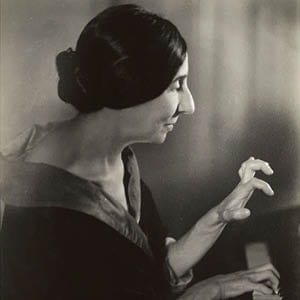The Library of Congress has posted a very interesting video of a lecture and concert held at the Library’s Coolidge Auditorium on 25 May 2022. Titled “Restitution, Restoration and Repertoire: New Findings in the Wanda Landowska and Denise Restout Papers at the Library of Congress,” the event featured distinguished speakers, among them Carla Shapreau, Senior Fellow at the Institute of European Studies UC Berkeley and Bret Werb, Music Curator at the United States Holocaust Memorial Museum in Washington, DC, and ongoing collaborator with the Polish Music Center.
The heroine of the evening was, of course, Wanda Landowska (1879-1959)—the Polish virtuoso harpsichordist and pianist, who greatly contributed to the revival of the harpsichord in the early years of 20th century. Born in Warsaw, Landowska first studied piano with Aleksander Michałowski, one of the preeminent Bach and Chopin interpreters—composers who would feature prominently later on in Landowska’s career. She also studied composition in Berlin and took piano lessons from Maurycy Moszkowski, another brilliant pianist and fellow Pole who lived in Paris. Landowska eventually decided to settle there as well but, in the meantime, began to perform Bach in her harpsichord recitals by the early 1900s. A few years before the outbreak of World War I, Landowska toured Russia with a Pleyel harpsichord and later became professor of harpsichord at Berlin’s Hochschule für Musik from 1912-1919.
Landowska’s first American tour came in 1923 when she performed on Pleyel’s “Grand Modèle de Concert” harpsichords. Passionately interested in period sound, she acquired a sizeable collection of old keyboard instruments and also conducted musicological research into such Baroque-era composers as Bach, Couperin and Rameau. Landowska was the first artist to record Bach’s Goldberg Variations on a harpsichord in 1933. She toured extensively with concerts and spent some time in the United States, teaching at the Curtis Institute of Music in Philadelphia between 1925 and 1928.
Landowska’s harpsichord recitals in the 1930s and 1940s were quite a novelty and one can only chuckle at the reviewer of her October 1942 Town Hall performance in New York who observed that, “Wanda Landowska’s harpsichord recital last evening at the Town Hall was as stimulating as a needle shower” but later added that, “She played everything better than anybody else ever does … the way she makes music is so deeply satisfactory that one has the feeling of a fruition, of a completeness at once intellectual and sensuously auditory beyond which it is difficult to imagine anything further.”[1]
Steadily gaining recognition as a preeminent champion of her instrument, a number of composers (including de Falla and Poulenc) wrote concert works for her. In 1925 Landowska established the École de Musique Ancienne in Paris and after many years of residence there became French citizen by 1938.
Following the invasion of France by Nazi Germany in 1940, Wanda Landowska and her partner, Denise Restout, fled to the United States, arriving in New York on 7 December 1941, the day of the Japanese attack on Pearl Harbor. Her residence in suburban Paris was raided by the Nazis, who stole Landowska’s harpsichords, music manuscripts and various art objects. After living in New York city during the war years, Landowska retired to a country residence in Lakeville, Connecticut but continued to teach and perform until 1954. After she died in Connecticut on 16 August 1959, Landowska’s legacy, including a substantial portfolio of compositions and transcriptions, was preserved by Denise Restout, who also edited and translated Landowska’s writings on music and saw them published in the mid-1960s.

The Library of Congress lecture and concert was centered on the fascinating history of Landowska’s majestic Pleyel harpsichord, its peregrinations from France to Germany and its eventual return to the owner in Connecticut. In her presentation, “Tracing the Provenance of Wanda Landowska’s Nazi-Era Looted and Recovered Harpsichord,” Carla Shapreau gave much insightful detail and provided many slide illustrations reflecting the long peregrinations of Landowska’s favorite instrument. In turn, Thomas Sheehan, Organist and Associate Director of Music at Washington’s National Cathedral, performed works by Scarlatti, Byrd and Couperin as well as Landowska for the assembled audience on her beloved Pleyel that is now safely housed at the Coolidge Auditorium. In-between these musical and verbal entr’actes, Bret Werb gave a fine account of Landowska’s colorful life in Poland, Germany, France and America in his extensive presentation. Anyone interested in Landowska’s accomplishments and details of her artistic and domestic life should set aside the time to watch this excellent and informative program at: loc.gov/concerts/landowska-collection-may25.html
[1] Virgil Thomson writing for the New York Herald Tribune, October 22, 1942. Accessed at https://www.norpete.com/p0983.html?viewfullsite=1
[Sources: loc.gov, ]
